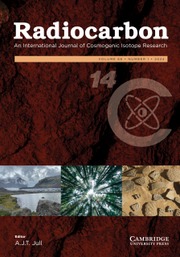Article contents
CALCIUM OXALATE RADIOCARBON DATING: PRELIMINARY TESTS TO DATE ROCK ART OF THE DECORATED OPEN-AIR CAVES, ERONGO MOUNTAINS, NAMIBIA
Published online by Cambridge University Press: 14 September 2020
Abstract
The direct dating of rock paintings is not always possible due to the lack of organic carbon compounds in pigments, or because sampling from a heritage site is often restricted. To overcome these limitations, dating laboratories have to develop new approaches. In this study, we consider sampling calcium oxalate crusts covering the painted artworks as a way to indirectly date the rock art. This stratigraphic approach includes isolating and extracting pure oxalate from the crusts. The approach was tested on natural bulk accretions collected in the open-air sites of Erongo Mountains in Namibia. The accretions were separated into two phases (pure oxalate and the remaining residues) with a special pretreatment. This process removes carbonates through acidification (HCl 6N) and dissolves the oxalate into the supernatant, leaving the minerals and windblown organic compounds in the residue. The efficiency of the separation was checked on the two phases by FTIR analyses and by 14C dating and showed that pure oxalate powders were indeed obtained. AMS radiocarbon results of various accretions on the same art panels provided ages from modern periods to 2410 ± 35 BP. From these first results, more targeted sampling campaigns can be considered to provide a terminus ante quem for the rock art.
- Type
- Conference Paper
- Information
- Radiocarbon , Volume 62 , Issue 6: Proceedings of the 9th International Symposium , December 2020 , pp. 1551 - 1562
- Copyright
- © 2020 by the Arizona Board of Regents on behalf of the University of Arizona
Footnotes
Selected Papers from the 9th Radiocarbon & Archaeology Symposium, Athens, GA, USA, 20–24 May 2019
References
REFERENCES
- 9
- Cited by



